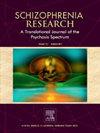在临床高危人群中,两个月的抗精神病药物暴露会引起特定领域的眼球运动改变。
IF 3.5
2区 医学
Q1 PSYCHIATRY
引用次数: 0
摘要
背景:虽然抗精神病药物引起的眼球运动改变在精神分裂症中有充分的文献记载,但其在临床高危期(CHR)的影响仍不明确。本研究考察了两个月的抗精神病药物治疗对CHR患者眼动参数的影响及其与临床结果的关系。方法:在这个纵向队列中,139名CHR个体和105名健康对照者完成了基线眼动追踪(注视稳定性、自由观看和平滑追踪)。CHR参与者在两个月时重新评估,并随访三年以跟踪缓解状态。线性混合效应模型检验了抗精神病药物的使用、剂量和类型对眼动指标的影响,随机森林模型评估了这些指标的变化如何预测临床缓解。结果:在抗精神病药物治疗亚组中,固定稳定表现为微眼跳增多,自由观视表现为眼跳幅度和速度降低,平滑追视表现为眼跳幅度降低而速度增加,且这些变化随剂量和药物的不同而不同,以阿立哌唑效果最显著。使用两个治疗引起的眼动变化值的随机森林分类器预测3年临床无缓解,受试者工作特征曲线下面积为0.80。结论:短期抗精神病药物暴露引起的混合眼动改变与三年随访未缓解相关。这一发现为在CHR人群中制定个性化风险分层框架和有针对性的干预策略提供了参考。本文章由计算机程序翻译,如有差异,请以英文原文为准。
Two-month antipsychotic exposure induces domain-specific eye movement alterations in clinical high-risk individuals
Background
While antipsychotic-induced eye movement alterations are well-documented in schizophrenia, their effects during the clinical high-risk (CHR) phase remain uncharacterized. This study examined the effects of two-month antipsychotic treatment on eye movement parameters in CHR individuals and their association with clinical outcome.
Methods
In this longitudinal cohort, 139 CHR individuals and 105 healthy controls completed baseline eye-tracking (fixation stability, free viewing, and smooth pursuit). CHR participants were reassessed at two months and followed for three years to track remission status. Linear mixed-effects models examined the effects of antipsychotic use, dose, and type on eye movement indicators, and a random forest model evaluated how changes in these indicators predicted clinical remission.
Results
In the antipsychotic - treated subgroup, fixation stability featured more microsaccades, free viewing showed reduced saccade amplitude and velocity, and smooth pursuit showed increased velocity gain with reduced saccade amplitude, and these changes scaled with dose and varied by agent with the most pronounced effects for aripiprazole. A random forest classifier using two treatment-induced eye movement change values predicted 3-year clinical non-remission with an area under the receiver operating characteristic curve of 0.80.
Conclusions
Short-term antipsychotic exposure induced mixed eye movement alterations that were associated with non-remission at three-year follow-up. This finding provides a reference for the development of personalized risk stratification frameworks and targeted intervention strategies in CHR populations.
求助全文
通过发布文献求助,成功后即可免费获取论文全文。
去求助
来源期刊

Schizophrenia Research
医学-精神病学
CiteScore
7.50
自引率
8.90%
发文量
429
审稿时长
10.2 weeks
期刊介绍:
As official journal of the Schizophrenia International Research Society (SIRS) Schizophrenia Research is THE journal of choice for international researchers and clinicians to share their work with the global schizophrenia research community. More than 6000 institutes have online or print (or both) access to this journal - the largest specialist journal in the field, with the largest readership!
Schizophrenia Research''s time to first decision is as fast as 6 weeks and its publishing speed is as fast as 4 weeks until online publication (corrected proof/Article in Press) after acceptance and 14 weeks from acceptance until publication in a printed issue.
The journal publishes novel papers that really contribute to understanding the biology and treatment of schizophrenic disorders; Schizophrenia Research brings together biological, clinical and psychological research in order to stimulate the synthesis of findings from all disciplines involved in improving patient outcomes in schizophrenia.
 求助内容:
求助内容: 应助结果提醒方式:
应助结果提醒方式:


